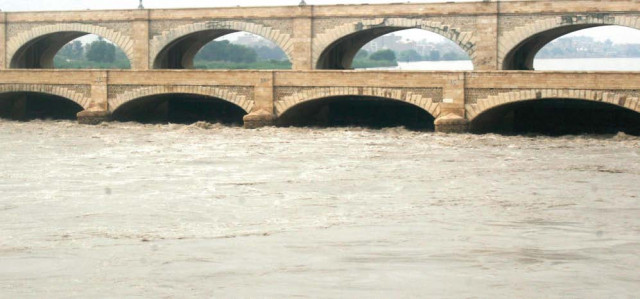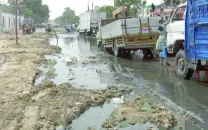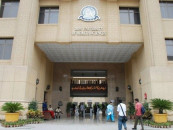Government works on plan to automate Sukkur Barrage gates
Sukkur Barrage road bridge closed for repairs amid plans to modernise the structure and automate the gates.

Instead of being closed for repairs from January 6 to January 20, the barrage has been closed for traffic from Friday, December 31 to January 31, 2011. Rangers have been deployed at both ends of the road.
Sukkur Barrage Executive Engineer Zareef Khero told The Express Tribune that the road has been closed because engineers of an international consultancy firm will visit and inspect the barrage for damages caused by the passage of the superflood. He said that engineers from the Associated Consulting Engineers and Burq Aab will inspect the superstructure of the barrage, while hydraulic experts will inspect its pavement and filter blocks. However, he was optimistic that the structure had survived the flood in one strong piece even though its discharge capacity has been reduced to 900,000 cusecs and during the flood, more than 1,100,000 cusecs water passed through it.
Modernisaton
Khero said a modernisation plan was approved in 2009 and under this new plan, 10 gates of the barrage that have been closed since 1942 will be opened.
He said that when the barrage was constructed, its water discharge capacity was 1,500,000 cusecs. But after a few years, mounds of silt accumulated in its right pocket, which hampered the supply to the canals on its right bank. The silt was also considered harmful for the structure of the barrage and so, 10 gates, from six to 14 and 23, were closed permanently. The rehabilitation plan includes reopening these gates on the condition that the silt problem will be solved first.
Khero said that the Sukkur Barrage was the first barrage constructed on River Indus and the technology used then is ancient now. The plan hopes to incorporate some of the modern technology and expertise used in the current construction of dams and barrages. The gates of the barrage are operated manually, using electricity. Under the plan, these gates will be made automatic so that an operator can easily open and close them while sitting in a control room.
As with every other year, the Sukkur Barrage chief engineer had announced the closure of the barrage and its off-taking canals so that routine repairs and the maintenance of the barrage gates and of the pavement and filter blocks of canals could be carried out. During these 20 days, the water supply to all seven canals is stopped and the water is released downstream. The pond level is thus reduced to five or six feet, making it easier for the technical staff to carry out their work.
According to irrigation sources, the repairs also include oiling and greasing of all the gates and canals. Since the canals are also empty, they can be examined for any damage.
The problem lies, however, in the fact that the funds meant for annual repair and maintenance are never used properly, said the sources. Had the funds been used properly then the large pit that developed in the pavement near gates 1 and 2 would never have occurred, they indicated towards 2004. A large pit, at least 40 feet deep, had disrupted the pavement around six years ago and was discovered during the annual closure. Realising the extent of damage, the federal government took about two years to make amends. Repairs were carried out in 2006 by the Frontier Works Organisation (FWO), at an estimated cost of Rs1 billion.
Published in The Express Tribune, January 1st, 2011.



















COMMENTS
Comments are moderated and generally will be posted if they are on-topic and not abusive.
For more information, please see our Comments FAQ